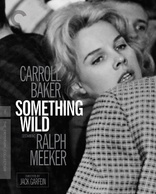Something Wild Blu-ray Movie
HomeSomething Wild Blu-ray Movie 
Criterion | 1961 | 113 min | Not rated | Jan 17, 2017Movie rating
6.9 | / 10 |
Blu-ray rating
| Users | 0.0 | |
| Reviewer | 4.5 | |
| Overall | 4.5 |
Overview
Something Wild (1961)
A young rape victim tries desperately to pick up the pieces of her life, only to find herself at the mercy of a would-be rescuer.
Starring: Carroll Baker, Ralph Meeker, Mildred Dunnock, Jean Stapleton, Martin KosleckDirector: Jack Garfein
| Drama | 100% |
Specifications
Video
Video codec: MPEG-4 AVC
Video resolution: 1080p
Aspect ratio: 1.67:1
Original aspect ratio: 1.66:1
Audio
English: LPCM Mono (48kHz, 24-bit)
Subtitles
English SDH
Discs
Blu-ray Disc
Single disc (1 BD)
Playback
Region A (locked)
Review
Rating summary
| Movie | 4.0 | |
| Video | 5.0 | |
| Audio | 5.0 | |
| Extras | 4.0 | |
| Overall | 4.5 |
Something Wild Blu-ray Movie Review
Reviewed by Dr. Svet Atanasov December 21, 2016Jack Garfein's "Something Wild" (1961) arrives on Blu-ray courtesy of Criterion. The supplemental features on the disc include new illustrated new illustrated interview with actress Carroll Baker; new filmed conversation between Jack Garfein and critic Kim Morgan; new video interview with scholar Foster Hirsch; and more. The release also arrives with an illustrated leaflet featuring an essay by critic Sheila O'Malley. In English, with optional English SDH subtitles for the main feature. Region-A 'locked".
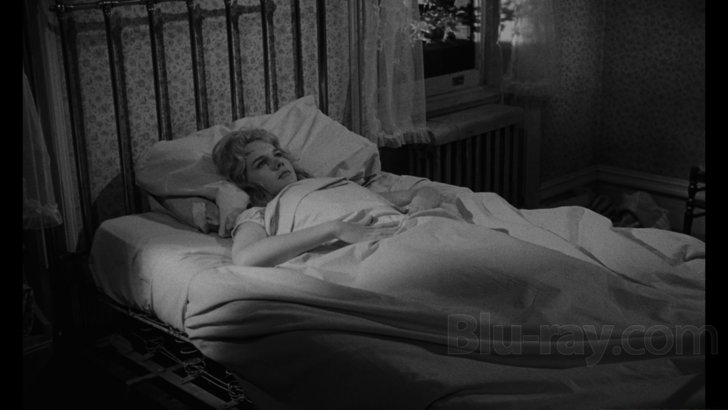
What do I do now?
Carroll Baker plays three different women despite the fact that the identity of her character is never altered. What changes is the personality of her character after a terrible event that takes place at the very beginning of the film.
Shortly after the opening credits disappear from the screen, the young and lively Mary Ann (Baker) is brutally raped in a park somewhere in New York City. It happens at night, in a dark alley where no one can see or hear Mary Ann desperately trying to reject her attacker. He overpowers her, and she surrenders under his heavy body.
The woman who emerges from the shadows and then quietly walks back to her family’s apartment is different. She looks at least ten, possibly even fifteen years older. All of the energy has left her body, and now she can barely function like a normal human being. She enters her room, and then her body and mind shut off at once.
In the days after the rape, Mary Ann does her best to look and act as if nothing in her life has changed, but she fails to hide the effects of the post-traumatic stress, and eventually her clueless mother decides to call the family doctor to examine her. The doctor, who is also completely clueless, tells Mary Ann to rest so that she can regain her strength. And eventually she does, but her mind refuses to restore her emotional balance. It begins rebelling, and after a while, it turns against her, punishing her with an onslaught of maddening ideas, uncontrollable anxiety, and a suffocating sense of guilt. In a desperate attempt to put an end to her misery, Mary Ann decides to commit suicide.
Moments before she jumps off the Manhattan Bridge, Mary Ann is saved by a stranger (Ralph Meeker, Kiss Me Deadly) who has quietly followed her from afar. The man then takes her to his place, offers her a meal, and invites her to stay for as long as she wants. When later that night he returns intoxicated and attempts to touch her, she hits him and seriously injures his left eye. On the following day, the man apologizes for harassing her, not realizing that now he has to wear a black patch over his eye because of her. They eat together, exchange a few words, and he invites her to stay a few more days. Eventually, Mary Ann decides to leave but discovers that her savior isn’t willing to let her go.
There is an interesting twist in Mary Ann’s relationship with the man that basically permanently forces her out of her misery and she becomes a different person. In this final phase of Mary Ann’s recovery, the film produces some very interesting observations about the way a victim (or a sufferer) can overcome the effects of the trauma that has irreversibly altered his life.
Something Wild is one of only two films directed by Jack Garfein, a Holocaust survivor who became involved with the notorious Actors Studio in New York City. Garfein and Baker, who was also a member of the Actors Studio, were already married when he shot the film in 1961.
What makes the film unique is the fact that it openly embraces the concept of method acting that Lee Strasberg and his followers at the Actors Studio promoted during the 1950s and 1960s. Essentially, there is a wide range of unfiltered emotions on display, and the situations that engage the actors are allowed to naturally evolve. So, instead of being overly concerned with the eventual dramatic resolution, Garfein shifts the focus of attention exclusively to the emotional state of the main characters.
A wide range of unfiltered emotions also defined the work of the directors that formed the Dogme movement during the 1990s (see Festen, Open Hearts). In these films, there was also a similar emphasis on the natural progression of the events they chronicled. However, they were bound by very specific technical restrictions that ultimately gave them a very precise structure. In Garfein’s film style, not structure, is of paramount importance because the city in which Marry Ann undergoes her transformations also becomes a key character.
Despite protests from local union leaders, Garfein shot the film with European cinematographer Eugen Schüfftan (Eyes Without a Face, Le Quai Des Brumes). The opening titles were created by the legendary Saul Bass (Psycho, Vertigo).
Something Wild Blu-ray Movie, Video Quality 
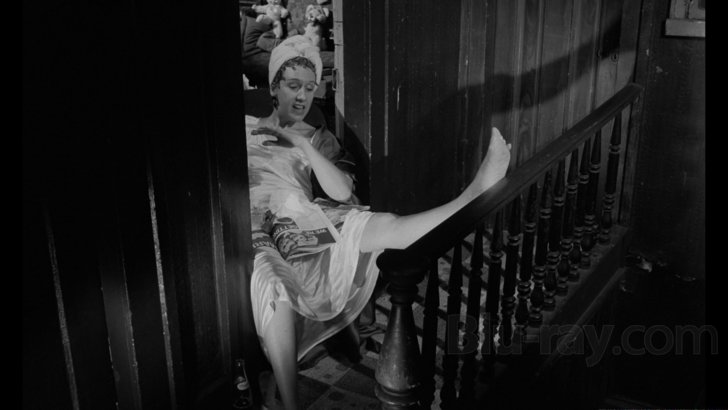
Presented in an aspect ratio of 1.67:1, encoded with MPEG-4 AVC and granted a 1080p transfer, Jack Garfein's Something Wild arrives on Blu-ray courtesy of Criterion.
The following text appears inside the leaflet provided with this Blu-ray release:
"This new digital transfer was created in 2K resolution on a DFT Scanity film scanner from the 35mm original camera negative. Thousands of instances of dirt, debris, scratches, splices, and warps were manually removed using MTI Film's DRS, while Digital Vision's Phoenix was used for jitter, flicker, small dirt, grain, and noise management. The monaural soundtrack was remastered from the 35mm original soundtrack negative. Clicks, thumps, hiss, hum, and crackle were manually removed using Pro Tools HD and iZotope RX.
Transfer supervisors: Jack Garfein, Lee Kline.
Colorist: Sheri Eisenberg/Deluxe, Culver City, CA."
A couple of years ago, I picked up MGM's on-demand DVD release of Something Wild, and while it was great to see the film then, the quality of the presentation was quite average at best even for these types of releases. Needless to say, the new 2K transfer that was struck for this upcoming Blu-ray release is quite the revelation. The biggest improvements are in terms of depth and stability. The nighttime and darker indoor footage are vastly superior -- there are details and nuances that cannot be seen on the DVD release, shadow definition is a lot more convincing (and in fact on an entirely different level), and the grayscale boasts a far better overall balance. Frankly, there are entire sections that look flat and fuzzy on the DVD release, while on the Blu-ray release, there is depth and fine nuances that give the film a vastly different cinematic ambience. There are a couple of segments with momentary density fluctuations, but it is easy to see that they are part of the original cinematography (all appear during the city shots). Grain is retained and never appears smeary. There are no problematic sharpening adjustments. On the DVD release, there are sporadic bumps, flicker, and other basic age-related imperfections that are eliminated here. Ultimately, the difference in quality between the old DVD release and the new Blu-ray release is indeed quite dramatic. (Note: This is a Region-A "locked" Blu-ray release. Therefore, you must have a native Region-A or Region-Free player in order to access its content).
Something Wild Blu-ray Movie, Audio Quality 
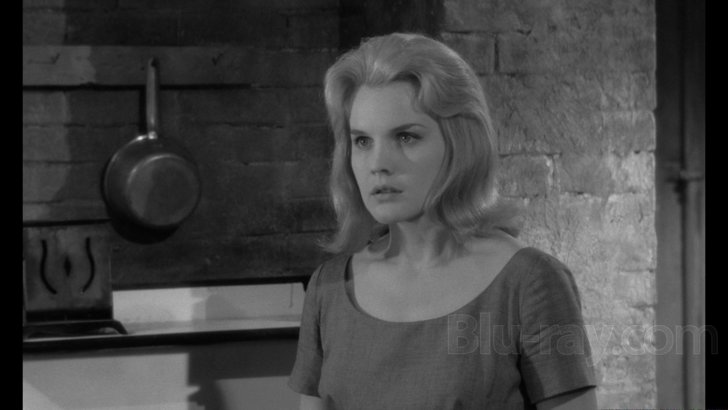
There is only one standard audio track on this Blu-ray release: English LPCM 1.0. Optional English SDH subtitles are provided for the main feature.
The film has a surprisingly complex score that was created by the great American composer Aaron Copland. On the DVD release, the music rarely makes an impression because the sound is frequently too 'thin' and there are some stability issues in the mid/upper registers. The lossless track on the Blu-ray gives the score much-needed stability and depth. I should mention that hiss and crackle have been eliminated as best as possible.
Something Wild Blu-ray Movie, Special Features and Extras 
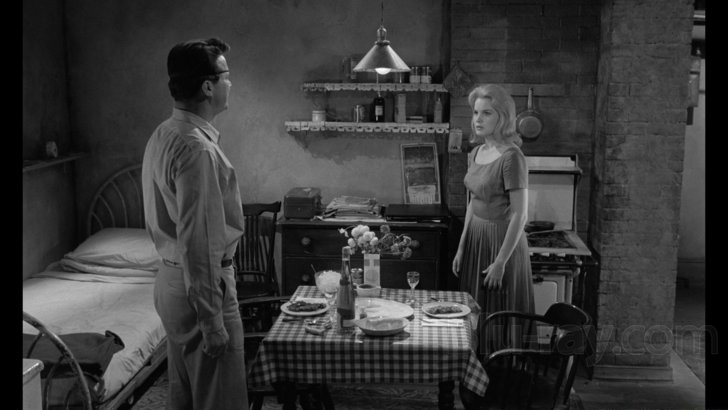
- Jack Garfein - in this piece, director Jack Garfein recalls how Lee Strasberg redirected his career and he was consequently able to shoot Something Wild, his interactions with various actors and directors in New York (James Dean, Elia Kazan, Ben Gazzara, Pat Hingle), the transformation of Carroll Baker's character and how it resembles the type of transformation that he experienced after he immigrated to America, the opening titles that Saul Bass created, etc. Also participating in the piece is critic Kim Morgan. Filmed exclusively for Criterion in New York in August 2016. In English, not subtitled. (27 min, 1080p).
- Carroll Baker - in this new illustrated interview, actress Carroll Baker recalls how she entered the film business after joining the Actors Studio and her interactions with Elia Kazan during the shooting of Baby Doll, and discusses some important sexual scenes she did in different films, her work on Harlow, her admiration for Clark Gabel, her work with Ralph Meeker on Something Wild, the change that Edward Dmytryk's The Carpetbaggers brought to her career, etc. The interview was recorded exclusively for Criterion in New York in September 2016. In English, not subtitled. (15 min, 1080p).
- Behind the Method - in this new video interview, scholar Foster Hirsch discusses the enormous impact the Actors Studio had on American cinema during the late 1940s and 1950s and the three actors whose work transformed it (Marlon Brando, James Dean, Montgomery Clift), Jack Garfein's time at the Actors Studio, the two films he directed and the qualities that define them, Lee Strasberg's philosophy of acting, etc. The interview was conducted exclusively for Criterion in New York in September 2016. In English, not subtitled. (21 min, 1080p).
- Master Class with Jack Garfein - presented here is a video program that features footage from Jack Garfein's famous acting class, which was recorded over two days in New York in 2014. In English, not subtitled. (39 min, 1080p).
- Leaflet - an illustrated leaflet featuring an essay by critic Sheila O'Malley.
Something Wild Blu-ray Movie, Overall Score and Recommendation 
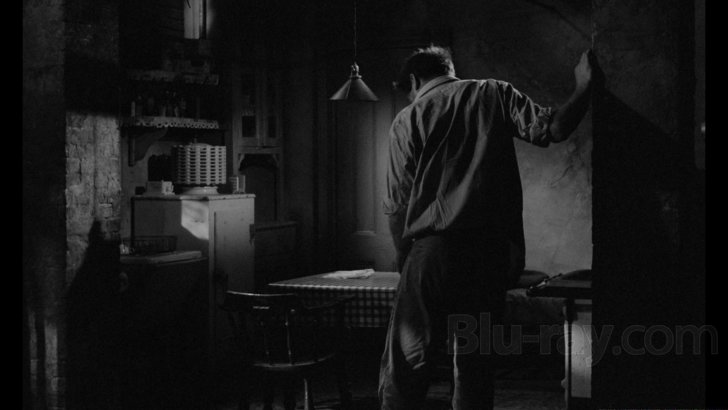
Jack Garfein's Something Wild would have been considered a masterpiece of American cinema if the style it promotes had evolved and matured in the same manner the French New Wave did. I saw it for the first time a couple of years ago when MGM released it on one of their on-demand DVDs and thought that it was quite incredible. Now the film has been restored in 2K under the supervision of director Garfein and looks tremendous on Blu-ray. The release also offers a great selection of new interviews, including one with scholar Foster Hirsch, whose analysis and historical information I thought were outstanding. VERY HIGHLY RECOMMENDED.
Similar titles
Similar titles you might also like

Ironweed
1987

Tommaso
2019

Welcome to New York
2014

Tiny Furniture
2010

The Pawnbroker
1964

The Landlord
1970

The Servant
1963

Sex Madness
1938

Heaven Knows What
2014

Aquarius
2016

Goodbye to Language 3D
Adieu au langage
2014

Out 1
Out 1, noli me tangere
1971

A Master Builder
2013

The Fire Within
Le feu follet
1963

Welcome to the Rileys
2010

The Farewell
2019

David Holzman's Diary
Special Edition
1967

Chained for Life
2018

Madigan
1968

Two for the Seesaw
1962
